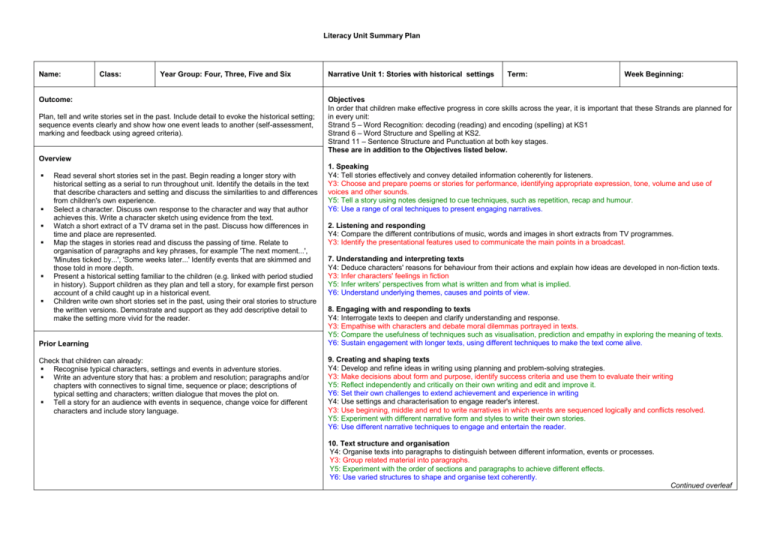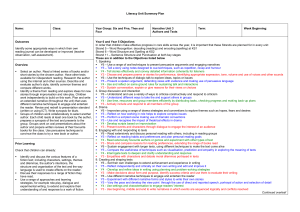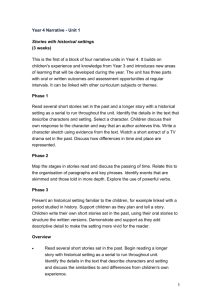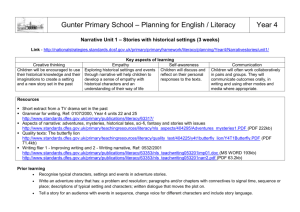Short extract from a TV drama set in the past
advertisement

Literacy Unit Summary Plan Name: Class: Year Group: Four, Three, Five and Six Outcome: Plan, tell and write stories set in the past. Include detail to evoke the historical setting; sequence events clearly and show how one event leads to another (self-assessment, marking and feedback using agreed criteria). Narrative Unit 1: Stories with historical settings Term: Week Beginning: Objectives In order that children make effective progress in core skills across the year, it is important that these Strands are planned for in every unit: Strand 5 – Word Recognition: decoding (reading) and encoding (spelling) at KS1 Strand 6 – Word Structure and Spelling at KS2. Strand 11 – Sentence Structure and Punctuation at both key stages. These are in addition to the Objectives listed below. Overview Read several short stories set in the past. Begin reading a longer story with historical setting as a serial to run throughout unit. Identify the details in the text that describe characters and setting and discuss the similarities to and differences from children's own experience. Select a character. Discuss own response to the character and way that author achieves this. Write a character sketch using evidence from the text. Watch a short extract of a TV drama set in the past. Discuss how differences in time and place are represented. Map the stages in stories read and discuss the passing of time. Relate to organisation of paragraphs and key phrases, for example 'The next moment...', 'Minutes ticked by...', 'Some weeks later...' Identify events that are skimmed and those told in more depth. Present a historical setting familiar to the children (e.g. linked with period studied in history). Support children as they plan and tell a story, for example first person account of a child caught up in a historical event. Children write own short stories set in the past, using their oral stories to structure the written versions. Demonstrate and support as they add descriptive detail to make the setting more vivid for the reader. Prior Learning Check that children can already: Recognise typical characters, settings and events in adventure stories. Write an adventure story that has: a problem and resolution; paragraphs and/or chapters with connectives to signal time, sequence or place; descriptions of typical setting and characters; written dialogue that moves the plot on. Tell a story for an audience with events in sequence, change voice for different characters and include story language. 1. Speaking Y4: Tell stories effectively and convey detailed information coherently for listeners. Y3: Choose and prepare poems or stories for performance, identifying appropriate expression, tone, volume and use of voices and other sounds. Y5: Tell a story using notes designed to cue techniques, such as repetition, recap and humour. Y6: Use a range of oral techniques to present engaging narratives. 2. Listening and responding Y4: Compare the different contributions of music, words and images in short extracts from TV programmes. Y3: Identify the presentational features used to communicate the main points in a broadcast. 7. Understanding and interpreting texts Y4: Deduce characters' reasons for behaviour from their actions and explain how ideas are developed in non-fiction texts. Y3: Infer characters' feelings in fiction Y5: Infer writers' perspectives from what is written and from what is implied. Y6: Understand underlying themes, causes and points of view. 8. Engaging with and responding to texts Y4: Interrogate texts to deepen and clarify understanding and response. Y3: Empathise with characters and debate moral dilemmas portrayed in texts. Y5: Compare the usefulness of techniques such as visualisation, prediction and empathy in exploring the meaning of texts. Y6: Sustain engagement with longer texts, using different techniques to make the text come alive. 9. Creating and shaping texts Y4: Develop and refine ideas in writing using planning and problem-solving strategies. Y3: Make decisions about form and purpose, identify success criteria and use them to evaluate their writing Y5: Reflect independently and critically on their own writing and edit and improve it. Y6: Set their own challenges to extend achievement and experience in writing Y4: Use settings and characterisation to engage reader's interest. Y3: Use beginning, middle and end to write narratives in which events are sequenced logically and conflicts resolved. Y5: Experiment with different narrative form and styles to write their own stories. Y6: Use different narrative techniques to engage and entertain the reader. 10. Text structure and organisation Y4: Organise texts into paragraphs to distinguish between different information, events or processes. Y3: Group related material into paragraphs. Y5: Experiment with the order of sections and paragraphs to achieve different effects. Y6: Use varied structures to shape and organise text coherently. Continued overleaf Phase 1 – approx 6 days Phase 1 Learning outcomes Resources Read several short stories set in the past and a longer story with a historical setting as a serial to run throughout the unit. Identify the details in the text that describe characters and setting. Select a character. Children discuss their own response to the character and way that an author achieves this. Write a character sketch using evidence from the text. Watch a short extract of a TV drama set in the past. Discuss how differences in time and place are represented. Phase 2 – approx 3 days Phase 2 Learning outcomes Map the stages in stories read and discuss the passing of time. Relate this to the organisation of paragraphs and key phrases. Identify events that are skimmed and those told in more depth. Explore the use of powerful verbs. Phase 3 – approx 6 days Phase 3 Learning outcomes Present an historical setting familiar to the children, for example linked with a period studied in history. Support children as they plan and tell a story. Children write their own short stories set in the past, using their oral stories to structure the written versions. Demonstrate and support as they add descriptive detail to make the setting more vivid for the reader. Children can read stories with a historical setting and find evidence about the period when the story is set. Children write character sketches using evidence deduced from the text. Children can recognise the stages in a story and the way that events are linked. Children can identify powerful verbs in a text and can talk about their function. Children can plan a story with a clear structure including a build-up, climax or conflict, and resolution. Children can use connectives to show changes in time or place and the sequence of events. Children can write a complete narrative with their ideas organised into paragraphs. Short extract from a TV drama set in the past Grammar for writing, Ref: 0107/2000, Year 4 units 22 and 25 http://www.standards.dfes.gov.uk/primary/publications/literacy/63317/ Aspects of narrative: adventures, mysteries, historical tales, sci-fi, fantasy and stories with issues http://www.standards.dfes.gov.uk/primary/teachingresources/literacy/nls _aspects/404295/Adventures_mysteries1.PDF (PDF 222kb) Quality texts: The butterfly lion http://www.standards.dfes.gov.uk/primary/teachingresources/literacy/qua lity_text/404225/y4t1butterfly_lion/Y4T1Butterfly.PDF (PDF 71.4kb) Writing flier 1 - Improving writing and 2 - Writing narrative, Ref: 0532/2001 http://www.standards.dfes.gov.uk/primary/publications/literacy/63353/nls _teachwriting053201imp01.doc (MS WORD 193kb) http://www.standards.dfes.gov.uk/primary/publications/literacy/63353/nls _teachwriting053201narr2.pdf (PDF 63.2kb)











